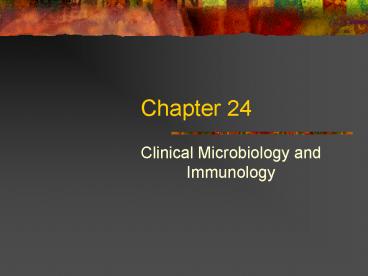Clinical Microbiology and Immunology - PowerPoint PPT Presentation
1 / 13
Title:
Clinical Microbiology and Immunology
Description:
blood, urine, feces, sputum, cerebrospinal fluid, pus. ... blood agar, supports the growth of most aerobic and facultatively aerobic organisms. ... – PowerPoint PPT presentation
Number of Views:339
Avg rating:3.0/5.0
Title: Clinical Microbiology and Immunology
1
Chapter 24
- Clinical Microbiology and Immunology
2
Growth-Dep. Clinical Diagnostic Methods
- Isolation of pathogens from clinical specimens
infected tissues or fluids are collected, ex.
blood, urine, feces, sputum, cerebrospinal fluid,
pus. - What steps should be taken to properly obtain
clinical specimens? - General purpose media ex. blood agar, supports
the growth of most aerobic and facultatively
aerobic organisms. - Enrichment media the addition of growth factors
allows metabolically fastidious to grow, ex.
Neisseria gonorrhoeae. - Selective media enhance the growth of certain
organisms while retarding the growth of others. - Differential media specialized media that allow
ID of organisms based on their appearance on the
media.
3
Blood Cultures
- Bacteremia presence of bacteria in the blood,
uncommon in healthy individuals. - Septicemia blood infection resulting from the
growth of a virulent organism entering the blood
from a focus of infection, results in fever and
chills and possibly septic shock including organ
failure.
4
Urine Cultures
- Common, causal agents often identical to normal
flora, ex. E. coli. Enteric bacteria account for
90 of UTIs. - Significant UTI 105 organisms per ml of
clean-catch specimen. - Dipstick tests test for nitrate production, etc.
related to large s of organisms in the urinary
tract.
5
Fecal Cultures
- Samples must be collected and preserved properly
and processed ASAP. - Processing includes inoculation into a variety
of selective media for isolation of individual
bacteria. - Intestinal parasites are IDed microscopically
rather than by culture.
6
Wounds and Abscesses
- Types of wounds include animal or human bites,
burns, cuts, penetration of foreign objects. - Wounds must be carefully sampled and results
carefully processed since normal flora are likely
to be present.
7
Other Specimens
- Genital specimens (ex. for gonorrhea) and
anaerobic specimens must be specially processed
in order to preserve the causal agents for proper
diagnosis.
8
Growth on Selective and Differential Media
- Unknown pathogens are first cultured on primary
isolation media and then subcultured onto
selective and differential media for further
diagnosis. - Eosin-methylene blue (EMB) selective (for gram
neg. bacteria) and differential (for diff. genera
of gram neg. bacteria). - Biochemical tests measure the presence or absence
of enzymes involved in the catabolism of
substrate(s) in the differential medium. - 100s of tests have been developed for clinical
use, though only 20 are used routinely. (see
Table 24.3) Some commercial kits contain a
battery of tests that ID and individual species,
ex. S. aureus, M. tuberculosis.
9
Testing Cultures for Antimicrobial Drug
Sensitivity
- Minimum Inhibitory Conc. (MIC) broth (or
antibiotic) dilution assay ? highest dilution
(lowest conc.) of antibiotic that completely
inhibits growth. - Kirby-Bauer disk diffusion method (see Fig. 24.8).
10
Safety in the Clinical Lab
- 1. Access to lab restricted.
- 2. Decontamination procedures.
- 3. Personnel must be adequately vaccinated.
- 4. All clinical specimens should be considered
infectious. - 5. No mouth pipetting.
- 6. Animals handled only by trained lab
personnel. - 7. Lab personnel must wear appropriate safety
equipment lab coat, sealed shoes, rubber
gloves, masks, eye protection, etc. - 8. All clinical specimens should be treated as
if they contain HIV.
11
Immunoassays for Infectious Disease
- Immunoassays detect and measure specific immune
responses to unique molecular portions of
pathogens, and are used especially on those
pathogens (ex. viruses) that are difficult to
grow. - New pathogen first infects individual ?
phagocytized ? phagocytes present Ag from
pathogen to T helper cells ? T helper cells
recruit and stimulate other phagocytes and B
cells ? B cells produce Ab (primary Ab response),
occurs within 5 days, but Ab do not reach peak
quantities for several weeks. - After 1st Ag exposure specific immunity via T and
B cells develops. After 2nd Ag exposure,
stimulation of these specific immune cells causes
a rapid and strong immune response, which quickly
destroys the pathogen. Thus, the immune system
has memory, which is characterized by and
increase in Ab titer (used to track infections).
12
Ab Titers, Skin Tests, Diagnosis of Infectious
Disease
- Serological tests are set up by making dilutions
of patient serum and determining the highest
dilution at which the Ag-Ab rxn. occurs. - 2 situations 1. Must see a rise in Ab titer to
conclude active infection (having Ab present
could mean prior infection or immunization and
not current infection). 2. The mere presence of
Ab is sufficient to indicate infection, ex. HIV. - Not all infections result in production of
systemic Ab, ex. Neisseria gonorrhoeae. - Skin testing ex. tuberculin text intradermal
injection of a soluble extract of Mycobacterium
tuberculosis ? pos. inflammatory rxn. at site of
injection current infection or previous
exposure to M. tuberculosis.
13
Polyclonal and Monoclonal Ab
- Antiserum (serum containing Ab) contains a
mixture of different Ab directed at the numerous
determinants on an Ag. This mixture of serum Ab
is called polyclonal Ab and, though they protect
the host, they do not provide reproducible
results for use in clinical diagnostic testing. - Only a few Ab are directed toward each Ag
determinant. Ab produced by a single B cell (or
in vitro clones of a single B cell) monoclonal
Ab. Monoclonal Ab do provide reproducible
results for clinical testing ex. for
immunological typing of bacteria, pregnancy
testing and blood typing.





![get [PDF] DOWNLOAD Medical Microbiology E-Book PowerPoint PPT Presentation](https://s3.amazonaws.com/images.powershow.com/10086233.th0.jpg?_=202407261011)

























